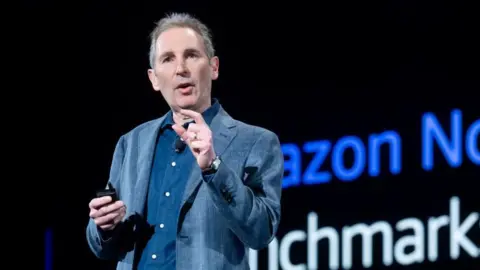In a significant announcement that highlights the ongoing transformation in the work environment, Amazon CEO Andy Jassy has conveyed to employees that artificial intelligence (AI) is expected to lead to substantial reductions in the company’s corporate workforce. This memo, shared with staff on Tuesday, emphasized the necessity for employees to familiarize themselves with AI, signifying a critical shift in the corporate culture at Amazon. Jassy’s message suggests that as AI technology continues to evolve and integrate into business operations, certain jobs will become obsolete, while others will be redefined.
Jassy articulated his expectations, stating that AI could facilitate “efficiency gains,” which would ultimately render some roles less necessary. He indicated that despite the uncertainty regarding the full impact of AI on employment, it is anticipated that the corporate workforce will shrink as a direct consequence of adopting these advanced technologies. The transition is framed as one where fewer employees will be required for existing jobs, while new types of roles will emerge, albeit potentially requiring different skill sets.
As the tech industry increasingly invests in AI solutions, the urgency surrounding these developments raises alarms about potential widespread job losses globally. Numerous companies, particularly in technology, have ramped up their focus on AI, leveraging advances in machine learning and natural language processing to streamline various functions. However, this surge in AI capabilities has led to mixed sentiments, with some industry leaders warning that the technology might decimate entry-level positions, particularly those in administrative or support capacities.
Dario Amodei, the CEO of AI company Anthropic, echoed these concerns, predicting that AI could potentially eliminate half of entry-level white-collar jobs. His statements coincide with apprehensions voiced by Geoffrey Hinton, a prominent figure in AI research—often referred to as the “Godfather of AI.” Hinton has suggested that AI technology represents a transformative phase that diverges from previous waves of technological innovation, where job creation often offset job losses. He questions the plausibility of new job creation in an era where AI can undertake most intellectual tasks.
The employee count at Amazon speaks volumes to the situation; as of the end of the previous year, the company employed approximately 1.5 million people globally, making it the second-largest employer in the United States after Walmart. A significant portion of Amazon’s workforce is engaged in logistics and warehouse roles; yet, around 350,000 workers fulfill various office functions. The implication made in Jassy’s memo signifies that those in administrative capacities may face the greatest risks as AI technologies gain traction within the company.
In his memo, Jassy underlined that Amazon is currently deploying AI across nearly all aspects of its operations, anticipating that the technology will soon manage routine activities, including shopping and personal tasks. He highlighted that while many AI-driven agents are still in development, he is confident they will arrive soon and rapidly transform the workplace landscape. Jassy urged employees to adapt to these changes, suggesting those who embrace and enhance their skills in conjunction with AI advancements would be the ones best positioned for future opportunities within the company.
To illustrate the integration of AI into the company’s ecosystem, he shared that approximately half a million sellers on Amazon’s platform are already leveraging AI tools to enhance product information. Moreover, advertisers are increasingly utilizing Amazon’s AI capabilities to optimize their offerings. This scenario illustrates a broader trend in which companies leverage AI to improve productivity and operational capabilities, although at the potential expense of job roles that were previously deemed essential.
In conclusion, as Amazon actively integrates AI technology into its business operations, the company sets a precedent for the tech industry. This realignment within corporate structures not only indicates a shift toward greater efficiency and automation but also foreshadows a challenging transition for the workforce. Employees must prepare for an unpredictable future dictated by the rapid pace of technological advancement, while the discussion around job displacement continues to evolve, underscoring the need for a proactive approach to workforce development.



